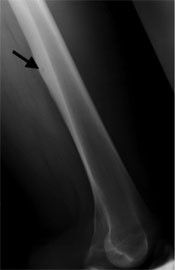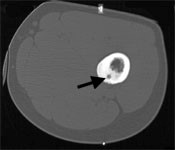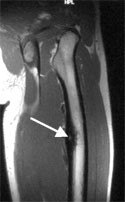Osteoid Osteoma
Original Editors - Michelle Quill from Bellarmine University's Pathophysiology of Complex Patient Problems project.
Top Contributors - Jacquelyn Moriah Facktor, Elaine Lonnemann, Admin, Chad Simmons, Michelle Quill, WikiSysop, 127.0.0.1, Rachael Lowe, Wendy Walker, Kim Jackson and Vidya Acharya
Definition/Description[edit | edit source]
A benign osteoblastic tumor consisting of vascular osteoid tissue centrally called the Nidus and sclerotic bone peripherally. Osteoid Osteoma does not grow or behave in a locally aggressive manner, and it has no potential for malignant transformation.Cite error: Invalid <ref> tag; name cannot be a simple integer. Use a descriptive title May initially appear on a radiograph as a small sclerotic bone island within a circular lucency.Cite error: Invalid <ref> tag; name cannot be a simple integer. Use a descriptive titleIn >50% of cases, the lesion occurs in the metaphysis and diaphysis of the long bones, particularly the femur and tibia. Other anatomic sites of involvement include the spine, upper extremity, pelvis, sacrum, ribs, hands, and feet.Cite error: Invalid <ref> tag; name cannot be a simple integer. Use a descriptive titleCite error: Invalid <ref> tag; name cannot be a simple integer. Use a descriptive titleCite error: Invalid <ref> tag; name cannot be a simple integer. Use a descriptive title
Prevalence[edit | edit source]
Osteoid osteomas account for 1/8 to 1/10 of symptomatic bone tumors and 5% of all primary bone tumors.[1]
Osteoid osteomas are the 2nd most common benign primary bone tumors resulting in 10-12% of all benign tumors.
Osteoid osteomas occur in children and young adults between the ages of 7 and 25. All ages can be effected but 75-80% of patients are less than 25 years of age. The male to female ratio is 2-3:1 putting boys and young males at the greatest risk for developing osteoid osteomas.Cite error: Invalid <ref> tag; name cannot be a simple integer. Use a descriptive titleCite error: Invalid <ref> tag; name cannot be a simple integer. Use a descriptive titleCite error: Invalid <ref> tag; name cannot be a simple integer. Use a descriptive titleCite error: Invalid <ref> tag; name cannot be a simple integer. Use a descriptive title
Characteristics/Clinical Presentation
[edit | edit source]
Presentation
Early
• local pain that is typically
more frequent and severe at night
and that is relieved with administration
of nonsteroidal anti-inflammatory
drugsCite error: Invalid <ref> tag; name cannot be a simple integer. Use a descriptive titleCite error: Invalid <ref> tag; name cannot be a simple integer. Use a descriptive titleCite error: Invalid <ref> tag; name cannot be a simple integer. Use a descriptive title
• local swelling and tenderness
Late
• bony deformity
• Gait disturbances
• muscle atrophy
• Leg length discrepancy (longer leg on involved side)
• Scoliosis (concavity same side as lesion)
• Growth Disturbances
• OA
Cite error: Invalid <ref> tag; name cannot be a simple integer. Use a descriptive title
Characteristics
• Most commonly found in diaphysis of long bones 70% of the time, the femur/tibia accounting for 55%, Phalanges of hands and feet 20%, and the spine 10% (lamina and spinous processes)Cite error: Invalid <ref> tag; name cannot be a simple integer. Use a descriptive titleCite error: Invalid <ref> tag; name cannot be a simple integer. Use a descriptive titleCite error: Invalid <ref> tag; name cannot be a simple integer. Use a descriptive titleCite error: Invalid <ref> tag; name cannot be a simple integer. Use a descriptive title
• Around 1.5 cm in sizeCite error: Invalid <ref> tag; name cannot be a simple integer. Use a descriptive titleCite error: Invalid <ref> tag; name cannot be a simple integer. Use a descriptive titleCite error: Invalid <ref> tag; name cannot be a simple integer. Use a descriptive titleCite error: Invalid <ref> tag; name cannot be a simple integer. Use a descriptive title
• Central Nidus, with circular lucencyCite error: Invalid <ref> tag; name cannot be a simple integer. Use a descriptive titleCite error: Invalid <ref> tag; name cannot be a simple integer. Use a descriptive titleCite error: Invalid <ref> tag; name cannot be a simple integer. Use a descriptive titleCite error: Invalid <ref> tag; name cannot be a simple integer. Use a descriptive title
• Osteoid Osteomas and osteoblastomas are histologically similar but differ in size, pain intensity, location, aggressiveness, and neural staining patternsCite error: Invalid <ref> tag; name cannot be a simple integer. Use a descriptive title
• Osteoid Osteomas are classified by their relative position to the bone: cortical, cancellous, intraarticular, and subperiostealCite error: Invalid <ref> tag; name cannot be a simple integer. Use a descriptive title
Due to the age of onset osteoid osteomas can easily be mis-diagnosed as a musculoskeletal disorder because when someone in their twenties reports pain, the vast majority of people assume the pain is musculoskeletal in nature.Cite error: Invalid <ref> tag; name cannot be a simple integer. Use a descriptive title The true diagnosis is easily overlooked because epiphyseal lesions mimic intra-articular derangement and pain is typically localized to the site of the lesion, so the location of pain can be anywhere, and may coincide with common sites of musculoskeletal inflammation or strain.Cite error: Invalid <ref> tag; name cannot be a simple integer. Use a descriptive titleAnother reason diagnosis is easily misled is that pain usually occurs before the lesions are visible on radiographs and in the early stages can be easily missed on a radiograph.Cite error: Invalid <ref> tag; name cannot be a simple integer. Use a descriptive titleFinally, these lesions may be associated with proliferative synovitis due to prostaglandin secretion that decreases range of motion, creates joint effusion, and can mimic inflammatory arthritis.Cite error: Invalid <ref> tag; name cannot be a simple integer. Use a descriptive title
Associated Comorbidities
[edit | edit source]
No known causes
Medications[edit | edit source]
Pain caused by osteoid osteomas can be relieved with aspirin and NSAIDS, which inhibit the prostaglandins released by the tumor cells. Prostaglandins cause changes in vascular pressure, which stimulates sensory nerve endings locally, causing pain. Inhibition of these prostaglandins relieves pain.Cite error: Invalid <ref> tag; name cannot be a simple integer. Use a descriptive titleCite error: Invalid <ref> tag; name cannot be a simple integer. Use a descriptive title Cite error: Invalid <ref> tag; name cannot be a simple integer. Use a descriptive title. Few studies have shown lasting affects of syptom relief after long term use of NSAIDS, some studies have shown without surigical management there is a probablity of evoltion into a osteoblastoma.Cite error: Invalid <ref> tag; name cannot be a simple integer. Use a descriptive title
Diagnostic Tests/Lab Tests/Lab Values[edit | edit source]
Osteoid osteomas can be detected on an MRI and CT scan, which are often used to identify the location of the nidus when the tumor is intra-articular. A CT scan will reveal the nidus as a small area of low attenuation surrounded by reactive bone formation, seen as a larger area of higher attenuation.Cite error: Invalid <ref> tag; name cannot be a simple integer. Use a descriptive title Cite error: Invalid <ref> tag; name cannot be a simple integer. Use a descriptive title
Radiograph reveals a well demarcated area of translucency (nidus) inside the bone, often times with a central calcified dot. This is surrounded by bony sclerosis. Usually less than 1 cm in size[2]
An osteoid osteoma can also be detected with bone scan, or scintigraphy, which will show a focal uptake of the radiotracer by the tumor.Scintigraphy is often used to detect an osteoid osteoma that is not easily seen on a radiograph, such as a vertebral tumor.Cite error: Invalid <ref> tag; name cannot be a simple integer. Use a descriptive title
Overall, CT scans are the best imaging tool for diagnosing osteoid osteomas.
•This is an X-ray of an osteoid osteoma of the thigh(femur) with increased bone formation and subtle lucency(arrow).Cite error: Invalid <ref> tag; name cannot be a simple integer. Use a descriptive title
•This is a CT scan of an osteoid osteoma of the thigh(femur), a small, round lytic focus(arrow) surrounded by dense bone is demonstrated.Cite error: Invalid <ref> tag; name cannot be a simple integer. Use a descriptive title
• This is an MRI of an osteoid osteoma of the thigh(femur). There is increased bone formation(dark)surrounding a brighter spot. The bright spot represents the nidus(arrow)of the osteoid osteoma.Cite error: Invalid <ref> tag; name cannot be a simple integer. Use a descriptive title
Causes[edit | edit source]
The actual cause of Ostiod osteomas is unknown. The nidus has been found to contian abundant nerve fibers within its matrix, adjacent to areas rich in arterioles. Prostoglanden synthesis has been shown to occur in the nidus. These reports suggest an important pathophysiologic role for prostaglandins both as mediators of pain and vasodilation that may stimulate the nerve endings by increasing the blood flow within the tumor.Cite error: Invalid <ref> tag; name cannot be a simple integer. Use a descriptive title An Osteoid osteoma is a vascular lesion consisting of an area of immature bone surrounded by osteoblasts and osteoclasts. The tumor starts with the nidus, or nest of vascular osteoid tissue in the center of the tumor. The nidus then becomes surrounded by reactive bone sclerosis. After the removal of the nidus, the secondary bone sclerosis generally disappears gradually.Cite error: Invalid <ref> tag; name cannot be a simple integer. Use a descriptive title
Systemic Involvement[edit | edit source]
Systemic involvement is uncommon with an osteoid osteoma.Cite error: Invalid <ref> tag; name cannot be a simple integer. Use a descriptive title
Stomach ulcers, heartburn and bleeding problems can occur due to the prolonged use of NSAIDs in pain management. Cite error: Invalid <ref> tag; name cannot be a simple integer. Use a descriptive title
Medical Management (current best evidence)[edit | edit source]
NonSurgical
• NSAIDS
Surgical (three most common operations)
1.Open Excision- intraoperatively cut out tumor, difficult for surgeon, hard to see. Can result in longer hospital stay for patient with activity and weight bearing restrictions. Oldest method.
2. CT-guided Percutaneous Excision-CT image guidance to remove nidus with excision
3. CT-guided Radiofrequency Ablation-CT image guidance to remove nidus with heat using probe (quick recovery, most common procedure today)
Physical Therapy Management (current best evidence)[edit | edit source]
None
Case Reports[edit | edit source]
This is a link to a slide show containing three examples of different presentations of Osteoid Osteomas.
http://eradiology.bidmc.harvard.edu/LearningLab/musculo/Leung.pdf
[[]]
Resources
[edit | edit source]
Recent Related Research (from Pubmed)[edit | edit source]
Failed to load RSS feed from http://eutils.ncbi.nlm.nih.gov/entrez/eutils/erss.cgi?rss_guid=1Tw-PbML7-DYFMNqCJQk2Uc9oSoDwpOXC3bH9wxuavtqL9EQiq|charset=UTF-8|short|max=10: Error parsing XML for RSS
References
[edit | edit source]
- ↑ Lenke LG, Sutherland CJ, Gilula LA.Osteoid osteoma of the proximal femur: CT-guided preoperative localization. Orthopedics. Mar 1994;17(3):289-92 fckLR
- ↑ Baggat M, Robbin M. emedicine.medscape.com/article/392850-media Case Eighty Four - Osteoid Osteoma retrieved from Musculoskeletal Imaging Teaching Files at http://www.uhrad.com/msiarc/msi084.htm









